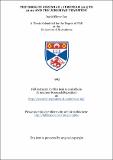Files in this item
The Book of Jeremiah : Jeremiah 30:5 to 31:22 and the Jeremiah tradition
Item metadata
| dc.contributor.author | Cox, David Elmer | |
| dc.coverage.spatial | 410 p. | en_US |
| dc.date.accessioned | 2018-06-07T10:58:02Z | |
| dc.date.available | 2018-06-07T10:58:02Z | |
| dc.date.issued | 1993-07 | |
| dc.identifier.uri | https://hdl.handle.net/10023/13800 | |
| dc.description.abstract | David Elmer Cox's thesis is a form critical study of the salvation/deliverance/hope poetic, prophetic oracles of the Hebrew Scriptures. Beginning with the archaeological concepts of pottery dating and stratigraphic analysis, Cox presents a methodology he classifies "Gattungen dating". Just as pottery forms are able to be used for dating purposes because of the continuous and measurable changes which developed in pottery as the needs and living circumstances of people changed, Cox proposes that the Gattungen utilized by the prophets of Israel proclaiming poetic salvation/ deliverance/hope oracles might also be used as a dating device because of continuous and measurable changes in oral address. Just as with pottery forms, Cox subjects the poetic salvation/deliverance/hope oracles of the Hebrew Scriptures to typological classification and chronological ordering. Isolating the salvation/deliverance/hope oracles outside of Jeremiah into pre-exilic, exilic and post-exilic period categories, Cox presents an evolutionary pattern of development within the salvation/deliverance/hope poetic, prophetic announcements (chapter two). Then, examining two passages scholars consider authentic Jeremiah (3:12b-13; 4:1-2), he applies the Gattungen dating methodology to determine that Jeremiah's salvation/deliverance/hope speeches reflected the concerns and Gattungen of the pre-exilic prophets (chapter three). Cox then examines the central nucleus of poetic salvation/deliverance/hope material within Jeremiah, 30(37):5-31(38):22, a section much debated as to its dating and Sitz im Leben. He determines that the Gattungen utilized by the poetic consolation collection are from a time later than Jeremiah of Anathoth. Through Gattungen dating procedure and historical-critical methodology, Cox proposes that 30(37):5-31(38):22 was a separate poetic collection which attained a recognizable textual shape in the early post-exilic period (chapter four). Cox proposes that the poetic consolation collection is an example of deutero-prophetic activity (chapter five). | en_US |
| dc.language.iso | en | en_US |
| dc.publisher | University of St Andrews | |
| dc.subject.lcc | BS1525.C7 | en |
| dc.subject.lcsh | Bible. Jeremiah, XXX-XXXI--Criticism, interpretation, etc | en |
| dc.title | The Book of Jeremiah : Jeremiah 30:5 to 31:22 and the Jeremiah tradition | en_US |
| dc.type | Thesis | en_US |
| dc.type.qualificationlevel | Doctoral | en_US |
| dc.type.qualificationname | PhD Doctor of Philosophy | en_US |
| dc.publisher.institution | The University of St Andrews | en_US |
This item appears in the following Collection(s)
Items in the St Andrews Research Repository are protected by copyright, with all rights reserved, unless otherwise indicated.

